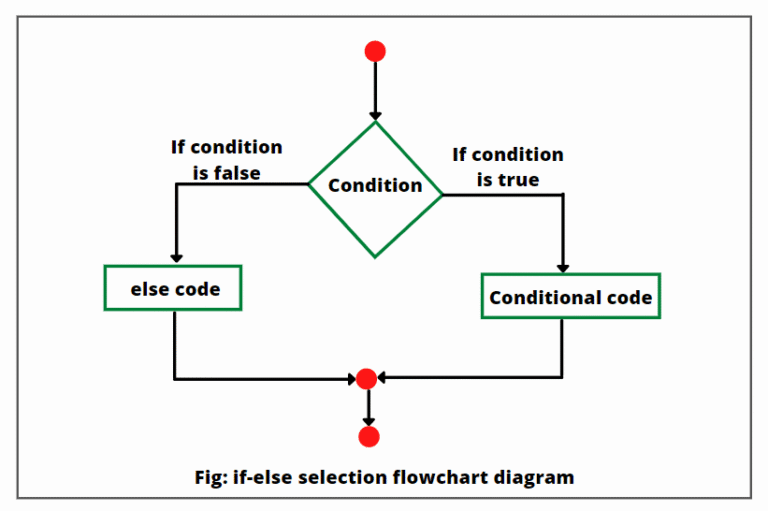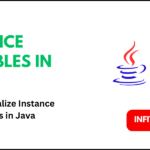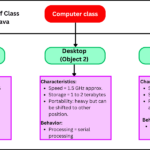Java is a high-level, versatile, powerful, and widely used object-oriented programming language developed by Sun Microsystems Inc. in 1991. It was developed for consumer electronic devices, but later it was shifted towards Internet.
Now, Java has become the widely used programming language for the Internet. Java programming language is known for its platform independence, robustness, and extensive libraries. If you write a program in Java language, you can run it on any hardware or on any operating system in this world.
Now you can use Java programming language to develop large-scale enterprise, to create web pages, and to enhance the functionality of Worldwide. Java is a preferred choice to build robust, scalable, and secure enterprise solutions.
Frameworks like Spring, Hibernate, and platforms like Jakarta EE (formerly Java EE) provide the necessary tools and libraries to develop complex applications that cater to business needs, such as customer relationship management (CRM) systems, enterprise resource planning (ERP) software, and financial services.
The powerful framework of Java, such as Spring Boot, Struts, and JSF (JavaServer Faces) make it an excellent choice for developing dynamic and interactive websites. These frameworks simplify backend development, enable efficient database integration, and support responsive design for better user experiences.

Table of Contents
History of Java Programming Language
Sun Microsystems in 1991 funded the research project named “Green” to design a programming language used in consumer electronic devices, such as televisions, VCRs, and washing machines. Since the processor chips of home appliance change on a continuous basis, the programming language used needed to be extremely portable. At that time, existing programming languages such as C++ were clearly not suitable for these purposes.
The embedded language was often tied closely to the appliance processor. Therefore, a new programming language was needed to be developed. James Gosling, Mike Sheridan, and Patrick Naughton aimed to develop a new programming language for home electronics appliances.
This new language was originally termed Oak referring to the tree that was outside the office window of the main developer, James Gosling. However, it was quickly renamed “Java”, inspired by coffee.
The use of Java for home appliance applications turned out to be initially unsuccessful, but the emergence of the Web gave it a new future. The first Java-enabled web browser HotJava was developed in 1994. After one year, Netscape incorporated Java support into its web browser.
Other companies quickly followed, and the popularity of Java rapidly rose. In 1995, Sun released Java 1.0 to the public, accompanied by the slogan “Write Once, Run Anywhere” (WORA). Sun Microsystems in 2007 made Java’s core code available as open source under the terms of the GNU General Public License (GPL).
In 2009, Sun was acquired by Oracle, which is currently continuing the development of Java. The below table gives an overview of the major releases, together with some key characteristics.
Table: Characteristics of Major Java Releases
| Major Release | Date | Key Characteristics |
|---|---|---|
| JDL 1.0 | 1996 | This is the first stable version of Java. |
| JDK 1.1 | 1997 | Inner classes; Java beans; JDBC; RMI; Just in Time (JIT) compiler for Windows platforms. |
| J2SE 1.2 | 1998 | Swing classes; Java IDL; Collections |
| J2SE 1.3 | 2000 | Java platform debugger architecture (JPDA); JavaSound; HotSpot JVM |
| J2SE 1.4 | 2002 | Regular expressions; IPv6 support; image I/O API; non-blocking I/O (nio); XML parser and XSLT processor |
| J2SE 5.0 | 2004 | Generics; annotations; autoboxing; enumerations; varargs; for each loop |
| Java SE 6 | 2006 | Improved GUI support; improved web service support |
| Java SE 7 | 2011 | New file I/O capabilities; support for new network protocols |
| Java SE 8 | 2014 | Lambda expressions; new date and time API |
| Java SE 9 | 2016 | Money and currency API |
Read here: JDK Releases
Evolution of Java Version Naming: From JDK to J2SE and Beyond
(1) Initially Called JDK (Java Development Kit):
- Early versions of Java were named based on their toolkit, starting with JDK 1.0, which was released in 1995.
- The “JDK” referred to the set of tools (compiler, debugger, etc.) used by developers to write and run Java programs.
(2) Rebranding to J2SE (Java 2 Platform, Standard Edition):
- Sun Microsystems introduced a new branding scheme with the release of Java 2 in 1998.
- The platform was divided into different editions to cater to varying application domains:
- J2SE (Java 2 Platform, Standard Edition): For desktop and general-purpose applications.
- J2EE (Java 2 Platform, Enterprise Edition): For enterprise and server-side applications.
- J2ME (Java 2 Platform, Micro Edition): For mobile and embedded systems.
(3) Return to JDK Naming:
- Starting with Java SE 5.0 in 2004, the “J2” prefix was dropped, and the naming reverted to JDK for development tools. For example:
- Java 5.0 was referred to as JDK 5.0 and Java SE 5.0.
Features of Java
There are the following important characteristics of the Java programming language that have made it so popular in the world of programming:
- Simple
- Secure
- Portable
- Object-oriented
- Robust
- Multithreaded
- Architecture-neutral
- Interpreted and High Performance
- Distributed
- Dynamic
1. Simple:
The syntax of Java is almost similar to C and C++ programming languages so that a programmer is familiar with C/C++ does not have to learn the syntax from scratch. However, several features of C/C++, which are either complex or result in ambiguity, have been removed in Java language.
- Java does not support multiple inheritance because the concept is a little bit complex and may result in ambiguity.
- Java does not support global variables, which also lead to many bugs in C/C++ programs.
- It does not use pointers and does not allow pointer arithmetic, which is the cause of most of the bugs in C/C++ programs due to inherent complexity.
- Java does not support operator overloading concept as it may lead to confusion.
- There is no concept of garbage value in Java. We have to initialize variables before use.
2. Secure:
Java programs run within the JVM (Java Virtual Machine) and they are inaccessible to other parts. This greatly improves the security. A Java program rarely hangs because of this feature. This is quite unlike C/C++ programs, which hang frequently. The security model of Java has three main components:
- Class loader
- Bytecode Verifier
- Security Manager
Java uses completely separate class loaders to load class files (executable files) from local machine and remote machines. The classes loaded from remote machines like Applet classes are not allowed for reading or writing files on the local machine system. This prevents a malicious program from damaging the local file system.
Bytecode verifier verifies the byte code as soon as class loader finishes its work. It ensures that byte code is valid Java code. It almost eliminates the possibility of Java program doing some malicious activity like accessing the memory outside the JVM.
The Security Manager acts as a gatekeeper within JVM which controls many critical operations like file deletion, creation of threads, etc. These operations are allowed only if the Java programs have sufficient permissions, otherwise Security Manager does not allow the operations and generates an exception named SecurityException.
3. Portable:
Java programs are platform independent, meaning that you can write once and run anywhere. If you write a Java program on Windows platform, you can also run it on any other platform such as Unix, Linux, Sun Solaris etc.) simply by copying the bytecode (“.class” files).
You don’t need to copy the source code and compile it again, as in the case of a C and C++ programs. This unique feature has made the Java a powerful language. You can run the bytecode on any machine provided that JVM is installed in the machine.
This is because JVM is itself platform dependent, but it makes the Java code platform independent. The main function of JVM is to convert the bytecode into machine code and executes them. So, we can say that Java a portable language.
One more feature which makes Java highly portable is that primitive data types are of fixed length irrespective of the platform. For example, an int will always be 4 bytes in Java. This is unlike C/C++ where the size of int can be 2 bytes on some machines and 4 bytes on other machines.
4. Object-Oriented:
Java is almost pure object-oriented programming paradigm by grouping data and operations into classes and/or objects. It supports primitive data types like byte, short, int, long, float, double, char, boolean for the performance reasons.
5. Robust:
Most programs fail due to one of the two main reasons:
- Memory management
- Exceptional conditions at runtime
While designing Java language, one of the objective was to develop a robust language where the program would rarely fail. To achieve this, special attention was given to the above two factors in the Java language.
Memory Management:
In Java, memory allocation and de-allocation are handled automatically by the language through garbage collection. This eliminates many problems caused by manual memory management, such as memory leaks and dangling pointers, which are common in languages like C and C++.
Exception Handling:
Java provides robust, object-oriented exception handling mechanism to handle runtime errors gracefully. This enables a Java program to detect, handle, recover and continue execution even after an exceptional condition occurs.
6. Multithreaded:
Java was designed to meet the real-world requirements for making interactive, networked programs. To achieve this, Java provides built-in support for writing multithreaded programs. This feature allows programmers to write application programs that can perform multiple tasks concurrently.
For example, in a Graphical User Interface (GUI)-based application:
- One thread can listen to user events (such as button clicks) and respond appropriately.
- Another thread can handle printing tasks.
- Yet another thread might download a file from some machine across the network.
All these tasks can be performed concurrently, which results better performance and better CPU utilization.
7. Architecture-neutral:
Programmers are facing one of the main problem is that there is no guarantee that if we write a program today, and it will run tomorrow even on the same machine. When operating system or processor upgrades and any change in the core system resources occur, then it can make a program malfunction. But the main goal of Java programs is “Write Once, Run Anywhere” (WORA)“.
This means that once written and compiled a Java program can run on any platform that has a compatible Java Virtual Machine (JVM), regardless of changes to the underlying hardware or operating system.
8. Interpreted and High Performance:
Java programs are interpreted but still they run fast as compared to other interpreters because of the following reasons:
a) Bytecode and JVM: A Java program is compiled into an intermediate form called bytecode, which is platform-independent. The Java Virtual Machine (JVM) interprets this bytecode at runtime, making the program portable across platforms.
b) Just-In-Time (JIT) Compilation: JVM uses a Just-In-Time (JIT) compiler to enhance performance. JIT is responsible for translating bytecode into native machine code at runtime. The execution of this native code is significantly faster than interpreting bytecode alone.
c) Optimized Runtime Environment: JVM employs various optimizations such as adaptive optimization, where frequently executed code paths are optimized further during execution.
9. Distributed:
Java is designed for the distributed environment of the Internet, which make it powerful for building networked applications. It has built-in support for various TCP/IP based protocols for this purpose. For example, accessing a resource using a URL in Java is similar to accessing a file on the local machine due to its robust networking APIs.
Java also has features for Remote Method Invocation, which is somewhat similar to Remote Procedure Calls (RPC). This allows objects on different computers to execute procedures remotely. Java has built-in API’s for this purpose called as RMI.
10. Dynamic:
In Java, every Java class is a separate unit of execution and is loaded in the memory at the run time only when it is needed. In addition to this, the default mechanism for method binding in Java is also dynamic (run-time binding or runtime polymorphism).
This means that the method to be invoked is determined at runtime based on the actual type of the object, not the reference type. This behavior enables Java to support polymorphism in object-oriented programming.
Running a Standalone Java Application
When a C or C++ program is compiled, it is directly translated into machine code of a particular processor or a platform. In contrast, running a Java program involves a two-step process:
(1) Java Compiler: Foremost Java program is compiled into an intermediate form called bytecode. Bytecode is just like machine code, but is platform-independent and cannot be directly executed.
(2) Java Interpreter (JVM): Java interpreter (i.e. JVM) with JIT compiler interprets the bytecode into native machine code for the specific platform at runtime.
Notes:
(a) C or C++ programs are compiled only once, but Java bytecodes are translated every time you execute Java programs. So, Java programs run a little slower as compared to C/C++ programs.
(b) To run a Java program you need a Text Editor like Notepad, JDK (Java Development Kit), and JVM which is already installed in many operating system. You can also use Ecllipse IDE or JCreater in place of Notepad.
Applications of Java
Java is a versatility programming language which allows it to be used in various domains. Some prominent applications include:
- Web Development: Java is widely used for creating dynamic websites and web applications. Frameworks like Spring, Struts, and Hibernate simplify web development, which provide robust solutions for backend services.
- Mobile Development: Java is the foundation of Android app development. The Android SDK relies heavily on Java, making it a preferred choice for mobile developers.
- Enterprise Applications: Enterprises use Java for making large-scale applications due to its scalability, reliability, and security. Technologies like Java EE (Jakarta EE) cater to enterprise-level requirements.
- Game Development: With Java, you can develop game using libraries like LWJGL and jMonkeyEngine. Its multithreading and graphics features enable the creation of interactive games.
- Cloud Computing: The portability and scalability of Java make it a suitable choice for cloud-based solutions.
- Internet of Things (IoT): Java is used for developing IoT applications due to its compatibility with diverse devices and secure architecture.






The clarity and simplicity of your writing are a perfect complement to the depth of the ideas you explore.